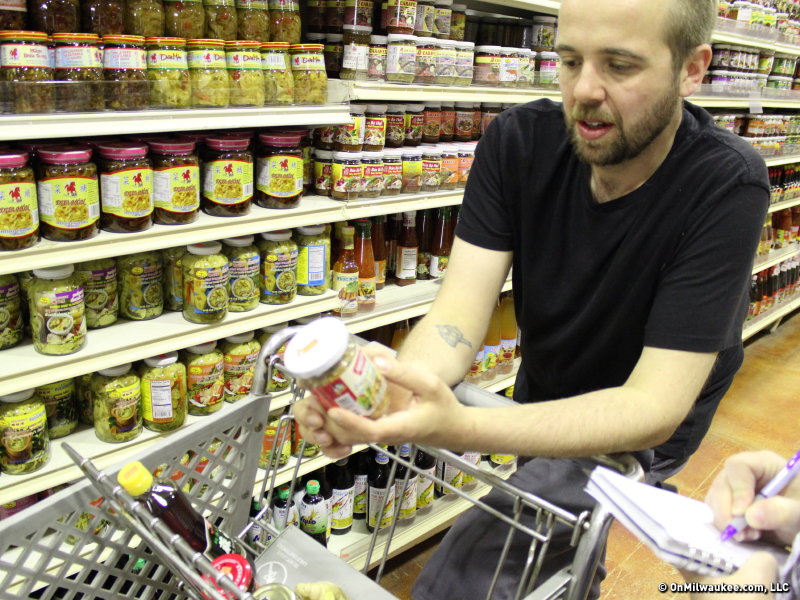Every chef has a "secret" passion. For Dan Jacobs of Wolf Peach, it’s Asian cuisine – an obsession that reared its head early on and persisted into adulthood.
"When I was a kid we used to go to this Chinese restaurant, Chang’s…" he says. "There was a lazy susan, platters of food … it was so fun. We always shared everything."
I’ll never forget my first interview with Jacobs. He was transitioning into his new role as executive chef at Roots, after the departure of Chef Paul Zerkel. I asked him an innocent question: "What’s in your refrigerator at home?"
His reply was telling.
"Lots of Asian stuff. Lots of condiments," he confessed. " My wife does a great job cooking, but when I cook at home I like to do Asian food. So there’s a lot of hoisins and soy sauces, rice wine vinegar and other sauces. Paul always liked to make fun of me for my sauce and rice vinegar obsessions. Lisa used to tease me that I drank the rice wine vinegar because it was always gone."
Since that time, I’ve had the opportunity to get to know Jacobs a bit better. And I managed to coax him into taking me on a trip to one of his favorite grocery stores, Viet Hoa/Pacific Produce, 5455 S. 27th St., the largest Asian market this side of Chicago.
I met Jacobs in the condiment aisle, where he was perusing the shelves with a look of mischief in his eyes.
"I could hang round the condiment aisle for hours," he confessed as he led me through the dizzying selection of products.
Our mission was to find a list of ten, or so, products that home cooks shouldn’t live without, which proved to be effortless with Jacobs as my guide.
He began by putting a jar of sesame oil into the cart, as he explained that its nutty flavor is the essence of a great many Asian dishes.
"The Kadoya is the best," he said as he handed me a bottle. "It smells like something an Asian mother would use."
We continued on, picking up Maesri chili paste with basil, a Thai-style condiment that Jacobs assured me was "perfect for soups," along with Mae Ploy sweet chili sauce, which he declared "essential for sweet and sour chicken."
Next up was the jar of fresh chiles in oil, which Jacobs says he uses often, despite the fact that his tolerance for spicy heat is relatively low.
"It totally boosts the flavor in anything," he says, handing me another jar, this time a small one filled with crab paste.
"This is great in soup too," he explained. "We make a corn chowder with crab in it, and this totally underscores the crab flavor. It’s delicious, incredibly savory, and not fishy at all."
Surprised that he’d suggested a distinctly "non-Asian" inspired use, I asked him how he determined how to use some of the condiments he picked up.
"It’s a matter of tasting and smelling … trial and error," he explained. "Sometimes I just buy things and try them out."
By the time we were done trolling the condiment aisle, the bottom of our cart was full. But, that didn’t dissuade Jacobs, who was busy analyzing the ingredient list on the back of a bottle of fish sauce.
"You need to be careful when buying Asian products," he told me. "Especially if you have food allergies. The labeling laws aren’t the same, and you can’t always tell if something contains an ingredient like gluten."
We sauntered through the produce department, which was chock-full with fruits and vegetables – some familiar, and others more exotic.
"The vegetables are great here," Jacobs noted. "And really cheap."
The day we visited, we spied lemongrass, garlic chives, bok choy, taro, kabocha (a fruit that resembles zucchini), mame nashi (dwarf pears), lychee, opo (also called calabash or bottle gourd), purple yams, and an impressive selection of mushrooms. We also found an entire cooler filled to the brim with durian fruit – a product that made Jacobs scowl.
"I’m not a fan," he said as I asked what the look was for. "It has the consistency of soft rotten peaches and tastes like sweaty bad onions."
The refrigerated goods section seemed to give him a renewed sense of satisfaction, and we spent at least five minutes glancing through the various types of fresh noodle products available.
"I don’t buy dried noodles," he said. "In fact, I personally like the rice cakes … they’re like Asian gnocchi."
He handed me a cryovaced package of white compressed rice discs, sometimes known as nian gao.
"I buy the fresh cakes," he went on, "Not the frozen. They sometimes crack."
I nodded, soaking in the unsolicited wisdom, and followed him to the case containing a variety of sausages, tofu products, and more exotic items, some unrecognizable.
"You’d never get me to eat one of those," Jacobs remarked, pointing at a package of black preserved duck eggs. But, he carefully chose a package of Lap Xuong, sweet Cantonese pork sausages. "These are delicious stir fried or in soup."
"I don’t buy many frozen items here," he remarked as we walked down the frozen foods aisle, "But, I do buy the circular wonton wrappers."
We tarried near the Japanese products aisle, which is sparse in comparison to other parts of the store.
"I miss the variety of Japanese products at Mitsuwa in Chicago," he mused, but excitedly picked up a package of Shin Ramyun. "This little package has 1000 percent of your daily intake of salt, but it’s so delicious, spicy … and really good when you’re hung over."
I laughed at his sudden change in disposition. "I’ll have to remember that," I responded.
Jacobs credits Shawn McClain of Spring and Green Zebra in Chicago for giving him his foundation in Asian cuisine.
"He used to take us to the market in Chicago and we’d experiment," he says. "It was a huge education."
He paused. "I still really love shopping in the Asian markets," he said. "They always have a distinct, pungent smell… and you have to be a little bit adventurous. But, it’s really rewarding in the end."
In case you’re interested in the list of pantry items Jacobs recommends, I’ve compiled it here. Stop back and let me know which ones you’ve tried, or if there are others you’d add to the mix.
- Kadoya sesame oil
- Maesri chili paste with basil – for soups
- Me Ploy sweet chili sauce – for sweet and sour chicken, dipping sauce
- Fresh chilies in oil
- Shrimp and crab paste – for soups and seafood dishes
- Chili garlic paste – for pho
- Chili black bean paste
- Koon Chun hoisin sauce
- Panda oyster sauce – great on sauteed mushrooms
- Sriracha
- Three Crabs fish sauce
- XO sauce – "delicious on vegetables"
- California Sausage – Lap Xuong
- Shin Ramyun
- Fresh rice cakes
As a passionate champion of the local dining scene, Lori has reimagined the restaurant critic's role into that of a trusted dining concierge, guiding food lovers to delightful culinary discoveries and memorable experiences.
Lori is an avid cook whose accrual of condiments and spices is rivaled only by her cookbook collection. Her passion for the culinary industry was birthed while balancing A&W root beer mugs as a teenage carhop, fed by insatiable curiosity and fueled by the people whose stories entwine with every dish. Lori is the author of two books: the "Wisconsin Field to Fork" cookbook and "Milwaukee Food". Her work has garnered journalism awards from entities including the Milwaukee Press Club. In 2024, Lori was honored with a "Top 20 Women in Hospitality to Watch" award by the Wisconsin Restaurant Association.
When she’s not eating, photographing food, writing or planning for TV and radio spots, you’ll find Lori seeking out adventures with her husband Paul, traveling, cooking, reading, learning, snuggling with her cats and looking for ways to make a difference.







